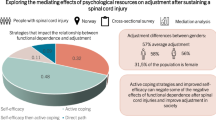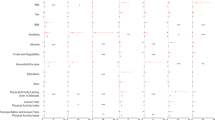Abstract
Study design:
Cross-sectional, correlational design.
Objectives:
To examine the effects of individual demographics, activities of daily living, social support, and self-concept on depressive symptoms in people with spinal cord injury (SCI).
Setting:
A convenience sample of 135 adults with SCI was recruited from medical and rehabilitation centres in Taiwan.
Methods:
Face-to-face, structured interviews were employed to collect information. Study questionnaires included a demographic sheet, the Barthel scale, the modified Social Support Inventory, the Huang self-concept scale and the Beck Depression Inventory. Data were analysed by structural equation modelling (SEM).
Results:
The average age of the participants was 43.3 years (±11.98), the mean duration of injury was 114 months (±93.78), and most were males. Emotional support (r=−0.173, P<0.05) and appraisal support (r=−0.261, P<0.01) were negatively correlated with depressive symptoms. The best fitted SEM model included individual demographics and physical function, social support and self-concept as significant predictors of depressive symptoms, with self-concept acting as a mediator in this relationship. Participants’ characteristics and social support both contributed substantial indirect effects on depressive symptoms via self-concept. Self-concept also mediated the relationship between education, income, physical functioning and participants’ depressive symptoms.
Conclusion:
For this sample, the more negative that individuals perceived themselves, the more likely they were to report worsening depressive symptoms. The more social support that individuals have, the more likely they were to report less depressive symptoms. Further longitudinal research will help clarify the direction of these relationships.
Similar content being viewed by others
Log in or create a free account to read this content
Gain free access to this article, as well as selected content from this journal and more on nature.com
or
References
Elfstrom ML, Kennedy P, Lude P, Taylor N . Condition-related coping strategies in persons with spinal cord lesion: a cross-national validation of the Spinal Cord Lesion-related Coping Strategies Questionnaire in four community samples. Spinal Cord 2007; 45: 420–428.
Hoffman JM, Bombardier CH, Graves DE, Kalpakjian CZ, Krause JS . A longitudinal study of depression from 1 to 5 years after spinal cord injury. Arch Phys Med Rehab 2011; 92: 411–418.
Saunders LL, Krause JS, Focht KL . A longitudinal study of depression in survivors of spinal cord injury. Spinal Cord 2012; 50: 72–77.
Muller R, Peter C, Cieza A, Geyh S . The role of social support and social skills in people with spinal cord injury - a systematic review of the literature. Spinal Cord 2012; 50: 94–106.
Post MW, van Leeuwen CM . Psychosocial issues in spinal cord injury: a review. Spinal Cord 2012; 50: 382–389.
Hupcey JE . Clarifying the social support theory-research linkage. J Adv Nurs 1998; 27: 1231–1241.
Krause N . Social support, stress, and well-being among older adults. J Gerontol 1986; 41: 512–519.
Schulz R, Rau MT . Social support through the life course. Academic Press, Inc: San Diego, CA, 1985, 129–149.
Barrera M, Sandler IN, Ramsy TB . Preliminary development of a scale of social support: studies on college students. Am J Community Psychol 1981; 9: 435–447.
Kaiser S, Kennedy P . An exploration of cognitive appraisals following spinal cord injury. Psychol Health Med 2011; 16: 708–718.
Hatcher MB, Whitaker C, Karl A . What predicts post-traumatic stress following spinal cord injury? Br J Health Psychol 2009; 14: 541–561.
Kennedy P, Lude P, Elfstrom ML, Smithson EF . Psychological contributions to functional independence: a longitudinal investigation of spinal cord injury rehabilitation. Arch Phys Med Rehab 2011; 92: 597–602.
Chen HY, Lai CH, Wu TJ . A study of factors affecting moving-forward behavior among people with spinal cord injury. Rehabil Nurs 2011; 36: 91–97127.
Geyh S, Nick E, Stirnimann D, Ehrat S, Michel F, Peter C et al. Self-efficacy and self-esteem as predictors of participation in spinal cord injury–an ICF-based study. Spinal Cord 2012; 50: 699–706.
Huang CY, Sousa VD, Tsai CC, Hwang MY . Social support and adaptation of Taiwanese adults with mental illness. J Clin Nurs 2008; 17: 1795–1802.
Geyh S, Peter C, Muller R, Bickenbach JE, Kostanjsek N, Ustün BT et al. The Personal Factors of the International Classification of Functioning, Disability and Health in the literature–a systematic review and content analysis. Disabil Rehabil 2011; 33: 1089–1102.
Lustig DC . The adjustment process for individuals with spinal cord injury: The effect of perceived premorbid sense of coherence. Rehab Counsel Bull 2005; 48: 146–156.
Chang CP, Tsai YF, Chen YC, Hwang SL . Factors related to depression among burns patients. J Nurs 2001; 48: 37–48.
Huang YD . Body image, ego-concept, associated factors, and life adjustation in physically disability adults [Unpublished Master Thesis]. National Chengchi University: Taipei, Taiwan, 1998.
Garver MS, Mentzer JT . Logistics research methods: Employing structural equation modeling to test for construct validity. J Bus Logist 1999; 20: 33–57.
Hoelter JW . The analysis of covariance structures: Goodness-of-fit indices. Sociol Method Res 1983; 11: 325–344.
Hoe SL . Issues and procedures in adopting structural equation modeling techniques. J Appl Quant Method 2008; 3: 76–83.
Jöreskog KG . A general approach to confirmatory maximum likelihood factor analysis. Psychometrika 1969; 34: 183–202.
Kline RB . Principles and practice of structural equation modeling, 2nd edn. Guilford Press: New York, NY, USA, 2005, xviiip. 366.
Steiger JH . Structural model evaluation and modification: an interval estimation approach. Multivar Behav Res 1990; 25: 173–180.
Beck AT, Ward CH, Mendelson M, Mock J, Erbaugh J . An inventory for measuring depression. Arch Gen Psychiatry 1961; 4: 561–571.
Pollard C, Kennedy P . A longitudinal analysis of emotional impact, coping strategies and post-traumatic psychological growth following spinal cord injury: a 10-year review. Br J Health Psychol 2007; 12: 347–362.
Smedema SM, Catalano D, Ebener D . The relationship of coping, self-worth, and subjective well-being: a structural equation model. Rehab Counsel Bull 2010; 53: 131–142.
Waldron B, Benson C, O'Connell A, Byrne P, Dooley B, Burke T . Health locus of control and attributions of cause and blame in adjustment to spinal cord injury. Spinal Cord 2010; 48: 598–602.
van Leeuwen CM, Kraaijeveld S, Lindeman E, Post MW . Associations between psychological factors and quality of life ratings in persons with spinal cord injury: a systematic review. Spinal Cord 2012; 50: 174–187.
Kennedy P, Duff J, Evans M, Beedie A . Coping effectiveness training reduces depression and anxiety following traumatic spinal cord injuries. Br J Clin Psychol 2003; 42: 41–52.
Author information
Authors and Affiliations
Corresponding author
Ethics declarations
Competing interests
The authors declare no conflict of interest.
Rights and permissions
About this article
Cite this article
Huang, CY., Chen, WK., Lu, CY. et al. Mediating effects of social support and self-concept on depressive symptoms in adults with spinal cord injury. Spinal Cord 53, 413–416 (2015). https://doi.org/10.1038/sc.2014.158
Received:
Revised:
Accepted:
Published:
Issue date:
DOI: https://doi.org/10.1038/sc.2014.158
This article is cited by
-
Perspectives on factors influencing quality of life in persons with long-term spinal cord injury: a qualitative study
Spinal Cord (2024)
-
Correlation between thyroid function, testosterone levels, and depressive symptoms in females with spinal cord injury
Spinal Cord Series and Cases (2019)
-
Social relationships, mental health and wellbeing in physical disability: a systematic review
BMC Public Health (2017)
-
Social support and its association with depression, gender and socioeconomic indicators in individuals with spinal cord injury in Iran
Spinal Cord (2017)



